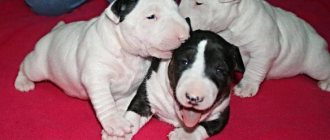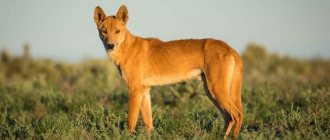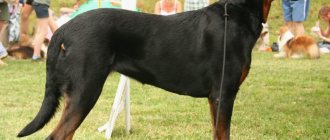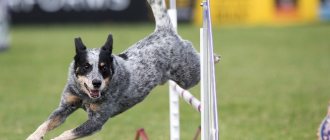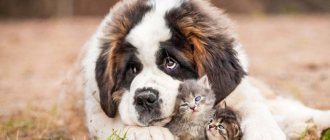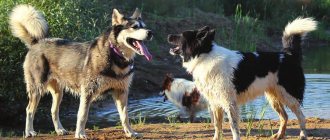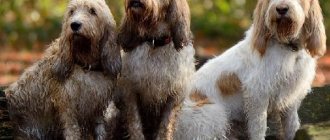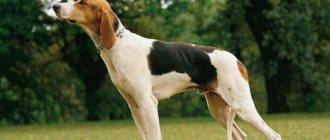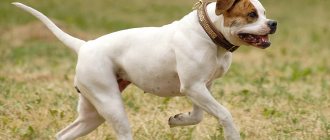Beagles are small-sized hunting dogs that have become incredibly popular due to their optimism, good looks, energy and loyalty.
Beagle puppies are so adorable that you can't resist them.
Adults do not lose this charm and charm, however, in order for a small puppy to grow into a loyal friend and protector, some effort will be required.
In this article we will talk about how to properly care for puppies of this breed, and also show you photos of these cute babies.
What do newborn puppies look like?
Newborn beagle puppies have no vision or hearing, and thermoregulation is very weak. They are absolutely helpless and completely dependent on their mother - she takes care of them, feeds them and warms them.
Adult representatives of the breed can be two-colored or three-colored, but at birth their coat is colored differently. Future tricolor owners are born almost black and white, with hard-to-see red markings on the face, while two-color beagles are light at birth, without pronounced multi-colored markings.
At birth, beagles weigh 250-450 grams, by 1 month they already weigh 1.5-2 kg and grow to 18-20 cm.
Appearance and standard
The standard was compiled by FCI No161 dated 10/13/2010 “Beagle”. Group "Hounds". Some are still confident that the dog is a French beagle, but according to documents, the country of origin is recorded as England, so there is little point in saying that the dog is not a real British.
There are several varieties:
- Representatives of mini - beagle or dwarf;
- Fox - beagles more reminiscent of foxhounds in appearance;
- Long-haired terriers - beagles;
- Medium-sized representatives, northern and southern types.
The modern beagle received a breed standard in 1957, then it was repeatedly changed and supplemented, and the American beagle brothers of their individual type began to differ less greatly in height and weight.
- At the moment, the weight of an adult beagle is 7.5 - 14.5 kg;
- The Beagle has a height at the withers of 30 to 40 cm.
By gender, males seem to be much larger than girls, more powerful and muscular. Young ladies are more petite and light.
For representatives, a prerequisite for the exterior is: well-developed jaws with sufficient strength;
- Large, expressive eyes - brown color, different saturation;
- Wide nose;
- Not elongated neck;
- Wide chest, tapering towards the stomach;
- Strong, thick tail, set high;
- Lips without much plumpness.
- Body: Well-developed and predominantly lean muscles, hips wide and strong. The paws are tightly packed, with rounded toes with black nails. The muzzle must have a painted mask, and the tail at the tip is white.
- Limbs: short, widely set, not crooked. The loin is wide and strong. The shoulder is medium, the collarbones are of free range.
- The head is of medium length, dome-shaped skull, scissor bite, well-developed tubercle on the back of the head.
- Outwardly, he is stocky without signs of weight, mostly well-fed, but without the formation of skin folds and the presence of excess weight.
Colors for Beagle dogs can be different.
- Tricolor (three-color) the presence of white, red and black.
- White beagle dog with various spots of a second color, for example: red, bright chestnut or light red.
- The black beagle is a rare occurrence; there is no completely uniform color, there are white spots or red spots predominate.
Beagle breed standard - full compliance of size and exterior characteristics, the presence of a typical color for a beagle and behavioral characteristics.
All serious deviations are considered in each case individually; if a representative does not meet the standard, then he is not allowed to participate in exhibitions or for breeding. At the same time, the dog can live in peace and his quality of life will not be affected.
Development by months
2-3 days after birth, the puppies’ umbilical cord falls off, and after a week they are already actively crawling around their “playpen”, orient themselves using their sense of smell, recognize the bitch and find each other. During the first 2 weeks they almost always sleep.
At about 10-14 days, puppies open their eyes, and at 14-17 days, their ear canals open, but they begin to clearly navigate, relying on these senses, by the end of the first month of life.
After 14 days of life, puppies begin to learn to stand on their paws, and by the beginning of 3 weeks they walk and play independently, and respond to noise. At the same time, their body temperature normalizes.
By 1 month of age, beagles already have baby teeth. The main food for puppies at this time is still mother's milk, but complementary foods are already being introduced.
By 2 months, puppies eat on their own. Typically, the first vaccination should be given at this time.
At 3 months, the puppy is maximally active and inquisitive, and the teeth begin to change. At about 6 months or a little later, baby teeth are replaced by molars.
The table below shows approximate growth rates of puppies by month:
| Age | Height at withers | Weight |
| 1-2 months | 22-25 cm | 3-4 kg |
| 2-3 months | 28-30 cm | 5-6 kg |
| 3-4 months | 30-32 cm | 7-8 kg |
| 4-5 months | 32-34 cm | 8-10 kg |
| 5-6 months | 33-35 cm | 9-12 kg |
| 7-8 months | 35-37 cm | 10-13 kg |
| 8-9 months | 35.4-37.3 cm | 10.5-14 kg |
| 9-10 months | 35.6-37.5 cm | 10.8-15 kg |
| 10-11 months | 36-38 cm | 11-16 kg |
| 11-12 months | 37-39 cm | 12-17 kg |
The maximum growth rate of puppies occurs up to six months. Then it slows down slightly, but the dog continues to grow up to 1 year, after which growth almost stops and the beagle continues to mature and form.
NOTE!
The maximum height at the withers allowed by the breed standard is 40 cm for a male and 30-38 cm for a female.
Adult beagle sizes for boys and girls
A moving beagle gives the impression of a swimming dog due to its proportional build: level back, good chest and correct angles of the hind legs.
Back in 1988, the English Beagle Club approved the standards for this breed. The standards for purebred dogs were determined: weight, height, proportions, color.
According to the breed standard , the height at the withers of a beagle should be: for a male - 36-41 cm, for a female - 33-38 cm .
The body length is average, in males it reaches 45-47 cm, in females - 41-43 cm.
The sternum is wide, reaching an average girth of 62 cm in males and 60 cm in females.
How to properly care?
During the first few weeks, the newborn puppies are cared for by a female dog. The breeder only needs to control the temperature in the room - puppies have almost no thermoregulation and hypothermia and overheating are dangerous for them.
The breeder must also remove the puppies' dewclaws, if any. This is done 3-5 days after birth.
Until the quarantine ends after vaccination, beagles are not allowed to be bathed, but their eyes must be examined and wiped daily.
IMPORTANT!
If puppies have purulent discharge, it is necessary to contact a veterinarian as soon as possible.
You should also regularly inspect and clean your puppies' ears and brush their fur several times a week.
After all the necessary vaccinations have been completed and the quarantine period has ended, you need to take your beagle for walks every day. These are energetic and active dogs - for normal physical and psychological health they need physical activity and active pastime.
Raising a Beagle puppy
Protect your apartment and valuables. Many people know the activity and restlessness of the Beagle dog.
Puppies, whose photos are simply touching, can do a lot of dirty tricks as they grow up. Some, in order to protect their apartment from pogrom, accustom their children to a crate.
You can learn about how pets can turn an apartment into hell in the article.
It's a simple process. First, put a treat in the crate and do not close the door behind the puppy.
After a while, lock him when he falls asleep, and when he wakes up, do not unlock him for about 15 minutes, no more. Then you should gradually increase this time.
A beagle puppy should have its own place. However, from time to time the dog will try to “capture” new territory. Therefore, if the little beagle lies down in the wrong place, carefully take the baby to his bed and say: “Place.”
Important! It is strictly forbidden to use a cage for punishment. The dog should perceive it as a house, not a prison.
If the puppy becomes indignant and demands to be released, try not to react.
Open the cage door only when the baby has calmed down, so that he understands that he cannot achieve anything by squealing and barking.
You cannot punish a Biglik for unwanted behavior by spanking him with your hand or shoving him with your foot.
A rolled up newspaper is suitable as a correctional rod. At the same time, you must clearly pronounce: “Ugh!”
The little beagle pokes his curious nose everywhere. It is important to remove all valuable and breakable things from his path.
To prevent your baby from chewing on wires, shoes and other objects, do not leave them within easy reach.
Make sure you have a variety of toys for your puppy so that he doesn’t look for them among your personal belongings.
Teach your puppy to the right commands. Even before walking outside, it is important to start teaching your dog the command “Come to me!”
To do this, catch the moment when the puppy is busy with his business, take a treat and call him: “Come to me!” As soon as the baby reacts and comes running to you, give him a treat.
Over time, you can call him from another room or when he is playing enthusiastically. Do this often.
Beagle puppy after a wild party
Give your child some freedom outside. However, do not get tired of “nodding” every 15-20 minutes, praising and encouraging the baby for the action performed.
There is no need to repeat the command several times in a row, thereby neutralizing its meaning.
Beagles are terrible “vacuum cleaners”, in this they are similar to St. Bernard puppies , they pick up whatever they like on the street.
Therefore, in addition to the command “Fu!”, it is advisable to accustom the puppy to the words “Give!” or “Spit!”
This is done according to the standard scenario: the baby is offered a tasty treat in exchange for what is in his mouth.
You can use a leash and gently pull the puppy back when he reaches for the “obscenity.”
The area where the beagle will live must be safe for him
Don't let him bite you. The chewing bites of a baby are cute, but the gripping of an adult dog's teeth is unpleasant and traumatic.
Therefore, wean your dog from biting when he is still at an innocent age.
To do this, when he gnaws at you or just intends to do so, you can scream loudly, making it clear that something wrong is happening.
If you can afford it, bite the biglik back.
Train the puppy to his place. From time to time the dog will try to “capture” new territory.
Adult beagles and puppies can behave in a similar way. The price of connivance is quite high; subsequently the dog will restore its own order all around.
Therefore, if the little beagle lies down in the wrong place, carefully take the baby to his bed and say: “Place.”
This should be done every time the puppy “forgets” where he can rest.
Biglik loves to play hide and seek. At first, he searches for a suitable place for a long time, and then waits for it to be found.
What to feed for the first 3 months?
During the first month, puppies eat only mother's milk, then complementary foods are gradually introduced.
If we are talking about dry food, then it should be at least premium class, preferably super-premium or holistic, and intended specifically for puppies. Before giving your pet food, it needs to be soaked in milk or broth.
With natural feeding, it is necessary that 70% of the diet consists of boiled lean meat, and the remaining 30% - cereals, milk, and vegetables.
NOTE!
With a natural diet, it is necessary to give beagles additional vitamins and minerals.
After 2 months, the diet should include:
- cottage cheese;
- cereals - oatmeal, buckwheat, semolina;
- kefir;
- boiled eggs;
- boiled vegetables;
- greenery.
At 3 months you can give puppies some sea fish and raw vegetables.
Feeding rules
Beagles are prone to overeating and obesity, so portion sizes and diet must be controlled.
The number of feedings depends on the age of the dog:
- up to 2 months – 6 times a day;
- 2-3 months – 4-5 times;
- 3-9 months – 3-4 times;
- 9-12 months – 3 times.
Upon reaching 1 year of age, the pet must be switched to two feedings a day.
In case of feeding with ready-made food, preference should be given to such manufacturers as:
- Hills;
- Royal Canin;
- Acana.
They must be marked “Junior” - such food is suitable for puppies up to 1 year old. In the future, the food should also be appropriate for the pet’s age.
A natural menu involves preserving foods consumed up to 3 months in the diet; after 4 months, offal should be given to the pet (udder, kidneys, liver, lung, spleen).
Boiled sea fish without bones can be given a maximum of 2 times a week.
You should also give your dog cartilage, moss, carrots and crackers twice a week - this helps clean the teeth and gums.
First vaccinations
Newborn puppies are protected by immunity received from their mother. This protection operates during the feeding period, but at the end of lactation it gradually weakens, replaced by the puppies’ own immunity.
To form an active immune system and protect against infections and viral diseases, vaccination is required in accordance with the basic rules:
- the dog must be absolutely healthy, otherwise there is a risk of death;
- You cannot vaccinate a pregnant or lactating bitch;
- 7-10 days before vaccination, the dog must be treated for parasites (worms, fleas, ticks).
The vaccination schedule includes vaccinations against:
- plague (D);
- hepatitis (H);
- adenovirus infection (A);
- parainfluenza (Pi);
- leptospirosis (L);
- parvo and coronavirus enteritis (P);
- rabies (R).
The drug is chosen by the dog owner. Vaccines of the Eurikan or Nobivak brands have proven themselves well.
There are several vaccination schedules:
| Scheme | Schedule and vaccine |
| Scheme 1 |
|
| Scheme 2 |
|
| Scheme 3 |
|
After the last vaccination, you must undergo a two-week quarantine; only after this the puppy can be taken outside.
In the future, vaccination should be carried out annually. In the case of using schemes 1 and 2, with the drug Nobivak DHPPI+LR, with scheme 3 - Eurikan DHPPI2+LR.
IMPORTANT!
Vaccination and revaccination are carried out using the same drug.
What factors influence development?
Owners of this breed should be aware that these animals are very difficult to train. Beagles are stubborn and need an owner with a firm hand and character. The main development time for these dogs is from birth to six months. During this same period, you need to train intensively. If you miss the moment, you won’t be able to catch up in the future, the animal will be uncontrollable and will cause a lot of trouble. The following factors influence the development of the beagle:
- proper maintenance of the mother during the intrauterine development of puppies;
- adequate care for newborn babies;
- access to fresh air;
- good affectionate attitude;
- suitable temperature in the room where the dogs are kept;
- quality food.
You cannot feed these animals sweet, fatty, or smoked foods. This will affect the overall health of the dogs as a whole.
As a reward, you can treat them with an apple and carrots. It is also necessary to carry out anthelmintic treatment in a timely manner and ensure that the diet contains enough all the necessary minerals and vitamins. The deficiency will affect the dog’s entire body, including the enamel of the teeth. An indicator of good development will be the presence of forty-two teeth in a seven-month-old puppy.
To ensure that the cubs do not lag behind in height and weight, in the first month, underweight babies are applied to the rear, fuller nipples of the mother. And also, if there are more than six newborns in the litter, care should be taken about artificial supplementary feeding. Infant formula is not suitable in this case, since it contains sugar; you need to choose food in accordance with the recommendations of the veterinarian.
After weaning the baby from its mother, it is also worth taking the advice of a specialist. Beagles can be fed with special food, or with natural products. With any choice, there should be a container of clean water next to the food bowl to avoid problems with digestion and stool, which largely determine the dog’s height and weight.
Gaining extra pounds is harmful for puppies; it is an extra burden on their still weak skeletal system.
The owner needs to monitor the composition of the food, the frequency of feedings and regularly weigh and measure his pet.
In addition, it is necessary to take care of the coat, check the ears and trim the nails . If all standards for caring for a beagle are followed, this dog can live about 15 years of a happy life. There are rare cases when these dogs live longer than this period.
How to bathe?
You can bathe the puppy for the first time only after the end of the two-week quarantine after the 2nd vaccination and only in case of emergency.
Beagles should not be bathed too often - once every 3-4 months is enough; more frequent washing will lead to dry skin.
You also need to make sure that the water is not hot and does not get into the dog’s ears. The shampoo should be soft, preferably moisturizing, intended for dogs.
Important! You cannot bathe your dog using human shampoos - they dry out your pet's skin, because... The pH of human skin is different from that of a dog.
Useful video
From the video you will learn everything about the Beagle dog breed:
The Beagle is an excellent scent hound. However, this dog is not only an excellent hunter, but also a wonderful companion, distinguished by attentiveness and curiosity, courage and affection, activity and intelligence. The beagle is also ideal for city life due to the fact that this breed demonstrates excellent balance and has a character without signs of aggression or cowardice.
Particularly noteworthy is the fact that the beagle learns easily and quickly. This feature, coupled with the dog’s trusting and gentle gaze, which is recognized as the official standard of the Beagle breed, delights and delights any person.
Beagles are incredibly fond of children. The dog behaves extremely delicately and carefully with them, which makes him a favorite of the whole family. The dog is absolutely unpretentious and very clean. Despite the high trainability of the breed, the dog owner must be persistent and patient during the training process.
Today, there are three lines of the dog breed in question:
In the Russian Federation, the latter (Beagle Harrier) is practically never seen even at rare breed exhibitions.
Dental care
Milk teeth appear in beagles by 1 month, and at the age of 3-4 months they begin to be replaced by molars. This process lasts up to six months, sometimes longer.
During this period, the dog needs toys that it can chew on, as well as various hard treats.
The change of teeth should be monitored and if abnormal growth of molars, wounds or swelling in the pet’s mouth is detected, it is necessary to show it to a veterinarian.
To avoid problems with teeth and gums, you need to brush your dog's teeth weekly with a special soft toothbrush and toothpaste. To brush a beagle's teeth, you need to open its mouth slightly with one hand and brush from the base of the tooth to the edge.
Breed Features
The Beagle is a fairly popular breed with English roots, classified as a hound dog. Very active, cheerful, with an inexhaustible flow of energy, she was originally bred to hunt hares. Currently, he is an excellent guard for a house or apartment, as he has a fairly ringing and shrill voice, as well as a faithful companion and assistant to his owner. Distinctive features of the animal are short legs and long drooping ears.
Being a hunting dog, the pet has a fairly high level of immunity. An energetic and curious dog for an equally active owner. Like a true hunter, he is always on the move and searching for prey. They are distinguished by perseverance, bright mind, self-confidence, and emotionality. A fair dose of patience will come in handy when interacting with your dog.
Puppies simply need to be exercised regularly, both physically and emotionally. This will help the proper development of the skeleton and muscles, and the release of energy will help relieve the nervous system. You can choose family walks in the park or adventures in the forest, where the beagle will give free rein to its natural hunting instincts.
As the dog gets older, he may become more and more lazy, sit at home and run only to his bowl. However, this should not be allowed, knowing about possible weight problems in an adult beagle.
When is a puppy separated from its mother?
The optimal age for weaning puppies from their mother is 1.5-2 months. At this age, they are already quite independent, but are not yet too attached to breeders and the environment, so adaptation to new conditions will be quick and easy.
In addition, at 45 days, a dog handler examines the puppies to determine breeding and evaluate the litter, so a puppy purchased at 1.5-2 months will have a puppy card confirming its compliance with the standard and the necessary vaccinations.
How to choose your future pet?
If you decide to choose a beagle puppy, first of all you need to pay attention to its physical condition.
In a healthy beagle:
- shiny thick coat evenly covering the body, no bald patches or dandruff;
- scissor bite;
- the nose is moist and cold, pigmented black, without discharge;
- the mucous membranes of the mouth are pale pink;
- the paws are strong, there are small seals in the area of the knee joints, there are no dewclaws;
- the eyes are shiny, the ears are clean, there is no discharge or odor;
- The male has 2 developed testicles, no signs of cryptorchidism.
The puppy must move confidently and be active, curious, and cheerful.
In males, stubbornness and independence are more pronounced - a boy is usually more difficult to educate and train, and is inclined to run after prey and a female in heat.
Bitches are more affectionate and obedient; training girls is much easier. Among their disadvantages are regular estrus, when they become the object of hunting by males. Also at this time they may experience changes in behavior.
NOTE!
If a dog is purchased for hunting, then there is no difference between a male and a female - the hunting instinct is equally developed in both sexes.
It is better to purchase a puppy from a specialized nursery after learning about the conditions of their care and the health status of the parents.
In case of purchasing a purebred representative of the breed, the breeder is obliged to present all the necessary documents:
- pedigree;
- birth certificate;
- veterinary passport;
- inspection report;
- application for registration in the club.
Character and behavior
There is no more loyal and cheerful dog in the world; he is famous for his endless energy and friendliness in communication. Energetic and cheerful, always ready to help the owner and loved ones.
The beagle's character as a real hunter is manifested in increased curiosity and an excellent reaction to danger. Gets along well with other animals and is safe for children.
- She loves communicating with people, is always friendly, loves to explore new places.
Hunting dogs and beagles are highly trainable, love training, and are always attentive and efficient. Loneliness is difficult to bear, and may become melancholy and refuse to eat.
- Requires constant physical activity, average type, active games. He is naturally intelligent and quick-witted, and has a good sense of the emotional component of a person. Able to intuitively assess the situation.
Sometimes he likes to chase cats and small rodents outside; pigeons give him special pleasure. At home he will behave more calmly; raising beagles begins from an early age.
The characteristic features of the Beagle breed are, like all hunting dogs, increased emotionality; sometimes they can do mischief, especially when they are alone for a long time, with insufficient active walking.


